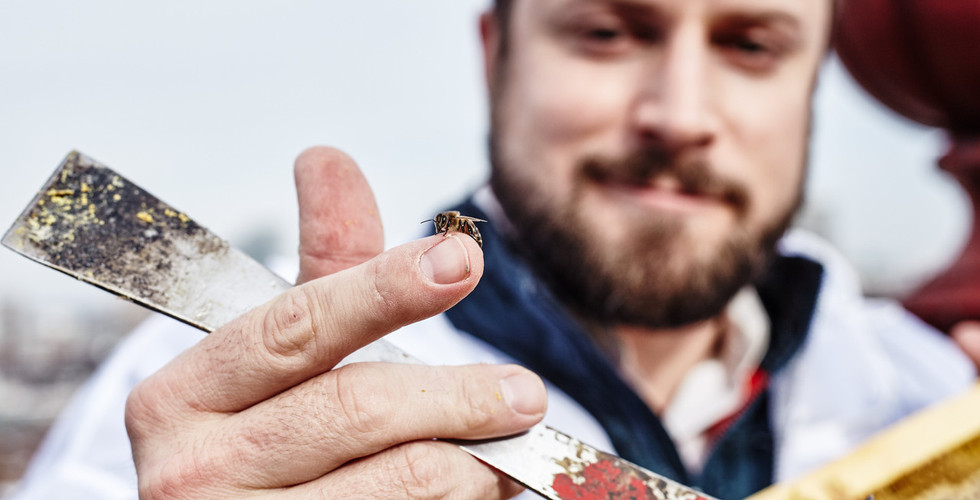WHAT'S IN YOUR BAG?
By HILARY POTKEWITZ
If you’ve ever wondered where bees go during the winter, wonder no more. “They stay inside and cuddle and eat honey,” says bee scientist Noah Wilson-Rich.
Mr. Wilson-Rich, 33, runs Best Bees Co., an urban-beekeeping venture based in Boston that installs and manages honeybee hives on buildings around the country.
Bees have their own version of central heating for winter: Thousands of worker bees flex their wing muscles, vibrating as a group around the queen. All that fuzzy friction raises their collective temperature to a balmy 90 degrees Fahrenheit. “The hive will be like Miami on the inside, even if it’s Boston on the outside,” he says. A healthy hive can house as many as 80,000 bees.
Mr. Wilson-Rich, who holds a Ph.D. in biology, has been preaching the gospel of urban beekeeping to commercial-property owners, hotels, universities and audiences at TED conferences. “A 2-foot by 3-foot space is enough for a beehive, and the bees will fly for miles to find flowers,” pollinating local fruit trees and vegetable gardens along the way, he says.
So far Best Bees has installed about 800 hives on rooftops in nine cities, usually through contracts with the buildings’ owners. Hives are humming atop the Wells Fargo Center in Denver and the Columbia Center in Seattle, both owned by client Beacon Capital Partners; on the Prudential Center in Boston, owned by Boston Properties; and above Airbnb’s headquarters in San Francisco. Best Bees also offers its clients custom bottling and labeling for honey.
Mr. Wilson-Rich, who founded Best Bees in 2010, travels regularly to help with hive issues, take research samples and meet with potential clients. The company has a nationwide staff of 39.
He always carries two duffel bags. One holds his beekeeping gear, which includes protective coveralls made of lightweight nylon and a zip-on veil that covers his head and neck. His gloves, made of leather, mesh and canvas, extend to the elbow, and his pants have stirrups that tuck into his boots.
He says he gets stung “about six or seven times a week, and for some reason, it’s always on my ankles.” Although he isn’t allergic, he always has hydrocortisone cream and an EpiPen in case other people get stung.
Before opening a hive, he calms the bees using a smoker. He fills its small metal drum with leaves, grass or wood chips, lights a fire then blows out the flame. With a billow he pumps a curl of smoke into the hive’s entrance. The smoke interferes with the bees’ antennae receptors, blocking communication, he explains.
He carries a set of hive tools—long metal spatulas with a hook at one end—used to pry open the hive’s lid, lift honeycomb frames or cut out diseased sections. He uses a bee brush to gently wipe live bees off the surface of a honeycomb so he can examine it.
He usually brings a bottle of seltzer, because beekeeping is sticky business, he says. “Everything is held together with beeswax and honey, and it gets all over,” he says. Sparkling water is a nontoxic way to clean up the mess.
On beekeeping days, Mr. Wilson-Rich avoids eating apples, bananas and almonds because the lingering scent can stimulate bees. “They’ll be drawn to my breath or to my face,” he says.
In his second duffel bag, Mr. Wilson-Rich carries marketing materials for his business and copies of his 2014 book, “The Bee: A Natural History,” about the deep-rooted connection between people and bees. He is currently on a speaking tour, combining client visits with scheduled talks about beekeeping in urban environments.
And he is on a mission to save honeybees. More than 130 U.S. crops, including apples, almonds and oranges, rely on bees for pollination, worth about $15 billion to the economy, according to the U.S. Department of Agriculture.
For the past decade, honeybees have been dying at an alarming rate -- about 30% of hives collapse each year, the USDA reports. Scientists are still trying to figure out the cause, with theories ranging from pesticides to disease, stress and lack of nutrition.
Mr. Wilson-Rich is researching ways to improve bee health, so he also carries test tubes to collect samples. He believes urban beekeeping is part of the solution. “Anybody who eats fruits and veggies needs bees. We have to protect our pollinators!” he says.
He was raised in Connecticut by his mother, after his parents divorced when he was 4. When he was in his 20s, and well on his way to a doctorate in honeybee immunology, his father told him that his grandfather also kept beehives. Mr. Wilson-Rich has few memories of “Grandpa Reg,” who died when he was a child. “But learning that made me feel really spiritual, like there was this connection between us,” he says.
These days, the beekeeper has two hives on the porch of his Dorchester, Mass., home. “We use them as cocktail tables,” he says. Hives have only one entrance, so it’s easy to direct honeybees to a desired flight path, he says. “The trick with urban beekeeping is to face the entrance to the wall, so the bees fly up and away from neighbors.”















